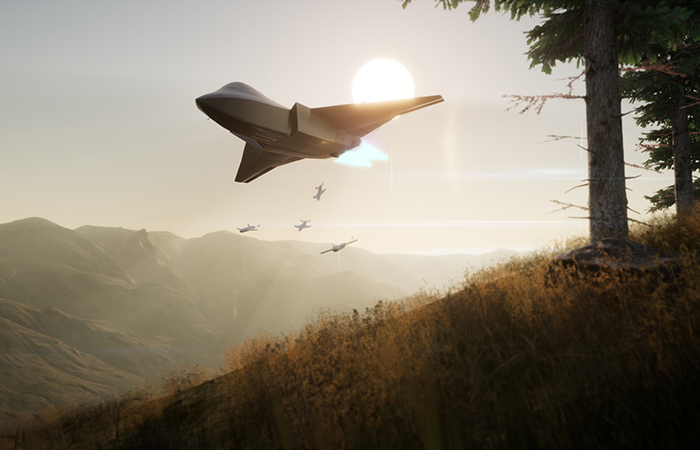
The Farnborough Air Show in July 2018 featured several new projects, concepts and prototypes but one that stood out was the Tempest, UK’s new combat aircraft. A number of companies are involved with this project including BAE Systems, Rolls-Royce, Italy’s Leonardo and missiles expert MBDA. Reports suggests that the UK will invest £2bn in the project with the aim of a first flight in 2035.
There is no denying that the UK has been a leader in aerial combat for over a century with a wide range of skills and technology. This latest project sends a clear message that they are determined to make sure they remain at the top. While The Tempest won’t patrol the skies anytime soon, it is the future of aviation and set to replace the existing Typhoon fighter jet.
According to UK defence secretary Gavin Williamson, “We are entering a dangerous new era of warfare, so our main focus has to be the future and today, we offer you a glimpse of tomorrow.”
Next-level Combat Aircraft
The current flagship for the Royal Air Force is the Eurofighter Typhoon and the Lockheed Martin F-35. Both fighter jets are effectively multinational efforts while The Tempest aims at improving upon them on British soil.
Sleek lines on The Tempest are designed to make it harder for radar detection but unlike the current crop of fighter jets, it could also operate as a drone without a pilot. It would also be the first British-designed combat aircraft equipped with laser directed energy weapons capable of shooting down aircraft and missiles.
The full-scale model of the new aircraft unveiled at the Farnborough Airshow looked largely like Lockheed’s F-22 Raptor with twin engines and two vertical stabilizers. According to the military, this jet is a sixth-generation fighter which would put the Brits ahead of America’s F-35 and F-22, Russia’s Sukhoi Su-57, and China’s Chengdu J-20. While this may be the case now, all of these countries, including France and Germany, are working on their own sixth-generation combat aircraft.
While the UK is currently not part of the latest fighter jet programme between France and Germany, they are not against working with other nations. According to Williamson, “It shows our allies that we are open to working together to protect the skies in an increasingly threatening future – and this concept model is just a glimpse into what the future could look like.”
Major Upgrades For The Tempest
A major hurdle for the Tempest combat aircraft is developing a highly complex stealth technology. The US has led this front for some time and an effective stealth program requires carefully chosen materials, manufacturing processes and immaculate design. Even the slightest miscalculation in any of these elements could literally mean the difference between life and death. In addition, the team also needs to take a closer look at the combat and sensor systems on the American F-35.
In terms of airworthiness, the fifth-gen fighter F-35 is somewhat sluggish and heavy for a fighter jet. The Tempest is already on the right path featuring a new Rolls-Royce engine equipped with an adaptive cycle engine. This relatively new technology optimises the engine for speed and range instead of focusing on either one or the other.
The main difference is the amount of air that the front fans push into the engine core where it mixes with fuel and detonates. The adaptive cycle engines are larger but also quieter than conventional jet engines. It should provide the best of both worlds with components allowing the aircraft to change airflow mid-flight.
Other technologies for the Tempest are still in early stages of development including a virtual cockpit and an AI autonomous flight system. While the virtual cockpit could replace conventional instruments and switches, the technology must be flawless in 10 to 15 years. There aren’t many pilots that will feel comfortable without having physical instruments in the cockpit.
Similarly, the AI flight system could allow the combat aircraft to fly without a pilot on board, coordinating with other fighter jets instead. While this technology could revolutionise air combat, it needs more R&D before replacing human pilots altogether.
Project Forecast
At the Farnborough Air Show, Williamson stated that they will invest £2bn in the development of Tempest up to 2020. The plan is to finalise design in early 2020 and then develop a flying prototype by 2025. From there, they want to enter the combat aircraft into service around 2035 but not before fully utilising the Typhoons.
They will gradually phase out Typhoons still in service over a five to 10 year period. At the same time, they will first test many of the systems developed for the Tempest on the Typhoons. This is to ensure that they can maximise their return on the Typhoon by implementing the capabilities onto the Tempest.
One last mention of advanced technology in the new combat aircraft is the possibility of drones in the payload bay. Using an aircraft like The Tempest to control a swarm of drones autonomously or remotely in battle is a very likely scenario.
For more interesting articles on emerging technologies, fabrication, advanced manufacturing and precision engineering, visit our blog site. You can also find us on social media or get in touch with our team of experts if you require assistance with your project. PRV Engineering manufacture for a wide range of industries include automotive, aerospace, defence, rail and construction.
This site uses Akismet to reduce spam. Learn how your comment data is processed.


 Mail:
Mail: 




Leave a Comments